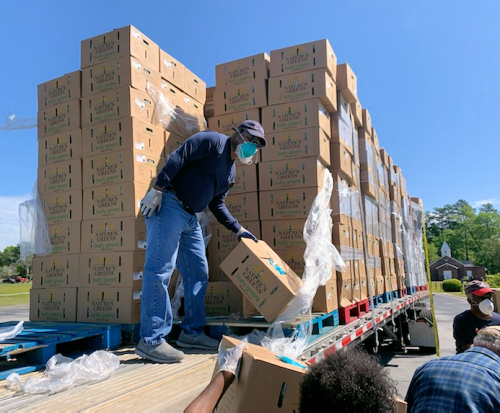By Jean Blish Siers *
By now we’ve all seen them: images of farmers plowing under crops or dumping vats of milk. People reach out to me, wondering what we can do to stop it. I’m proud to work for Society of St. Andrew, a nonprofit dedicated to saving good produce that would go to waste and getting it to those in need. We’ve been working overtime with very limited resources the past few weeks, trying to save everything we can.
 But what a lot of people don’t understand is that a field being plowed under isn’t something new. Food waste goes on every day. Every. Single. Day.
But what a lot of people don’t understand is that a field being plowed under isn’t something new. Food waste goes on every day. Every. Single. Day.
Sometimes it’s because our labyrinth-like immigration policy keeps farmers from getting the help they need to harvest their crops. Sometimes it’s that a grocery store or distribution center decides they have too many onions or watermelons. Or what arrives in their warehouse isn’t quite pretty enough. It’s destined for a landfill if someone like Society of St. Andrew doesn’t intervene.
Whatever the reason, even in the best of times, 40% of food in America goes to waste. And more produce is wasted (either plowed back under, or harvested and then discarded somewhere along the way) than is eaten. Read that sentence over again. More than 50% of produce raised in our country goes to waste.That’s nothing to do with the pandemic. It’s our broken food system: We expend countless resources planting, watering, fertilizing, harvesting, then transporting it, simply to throw produce away because it’s less than perfect or arrived a day late.
I have a theory why suddenly people have a visceral reaction to all this waste. I think for many of us, this is the first time we’ve faced any sort of long-term shortages of the things we regularly purchase. We go to our grocery store to stock up on necessities once a week or so, and suddenly there is no lettuce. Or there is lettuce but no potatoes or onions. Toilet paper has gotten everyone’s attention, but stores are having trouble keeping lots of food items on shelves, everything from produce to flour, from canned vegetables to eggs. As meatpacking plants close, chicken and pork could be next.
 Why are we seeing those empty spaces in our usually overly full grocery stores? Basically, it’s two sides of the same coin. We’re eating at home more with schools and colleges closed. People who ate lunch out every day are hoping for a salad at home, where they’re working now. We’re cooking more, baking more.
Why are we seeing those empty spaces in our usually overly full grocery stores? Basically, it’s two sides of the same coin. We’re eating at home more with schools and colleges closed. People who ate lunch out every day are hoping for a salad at home, where they’re working now. We’re cooking more, baking more.
And on the supply side, growers and producers who normally provide food for those larger institutions (restaurants, hotels, schools, arenas) can’t easily shift their production and packaging to supply grocery stores instead. It’s not economically feasible to make those long-term changes in the short term.
At the same time, we are find shortages at our stores, we’re seeing sobering photos of people lined up for hours at food banks, waiting for a box for their families. These are people who lost their jobs through no fault of their own: restaurant workers, dog walkers and house cleaners, the people who cut our hair or polish our nails. This list goes on and on. It all brings hunger and scarcity much closer to us.
I hope that when all of this is behind us, we remember that feeling of going to the store and being unable to fill our carts with whatever we want. That is how the 15-25% of Americans who live with food insecurity feel every day. Even if they can get to the grocery store (and many can’t easily get to a full service grocer) they don’t know what they can bring home. What can they afford? Do they have any money left by the end of the month? What will last in their cupboards and feed their children day in and day out? What can they carry on the bus?
If nothing else comes out of this crisis, maybe we can all remember that we are a community that is both fragile and interconnected. I want us to remember the inequalities that have existed for years but are suddenly exposed: That people who work hard for us on what we now call the “front lines” don’t make wages that allow them to rent a safe apartment, drive a dependable vehicle, or feed and clothe their families with confidence. We are grateful for them now, stocking shelves and manning the drive-throughs and driving delivery trucks and cleaning public spaces, but will we remember them once we have a vaccine?
It’s heartening to see so many people concerned about food waste and the struggles of the agricultural system. I hope we remain motivated to support local farms, to buy local produce and meats. I hope we have internalized the struggles of trying to get food on the table when you don’t know what you can bring home. I hope we remember that our neighbor’s struggle can easily become our struggle, as it has for so many this year.
* Jean Blish Siers is SoSA’s Western NC, Charlotte Area, and South Carolina Program Coordinator
MAY
2020

